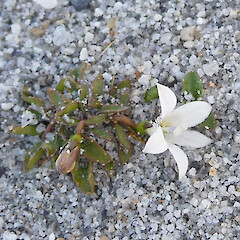Wahlenbergia congesta
Common name
harebell
Synonyms
Wahlenbergia congesta (Cheeseman) N.E.Br. subsp. congesta, Wahlenbergia congesta subsp. haastii J.A.Petterson, Wahlenbergia morganii Petrie, Wahlenbergia saxicola var. congesta Cheeseman
Family
Campanulaceae
Flora category
Vascular – Native
Endemic taxon
Yes
Endemic genus
No
Endemic family
No
Structural class
Herbs - Dicotyledons other than Composites
NVS code
The National Vegetation Survey (NVS) Databank is a physical archive and electronic databank containing records of over 94,000 vegetation survey plots - including data from over 19,000 permanent plots. NVS maintains a standard set of species code abbreviations that correspond to standard scientific plant names from the Ngä Tipu o Aotearoa - New Zealand Plants database.
WAHCON
Chromosome number
2n = 36
Current conservation status
The conservation status of all known New Zealand vascular plant taxa at the rank of species and below were reassessed in 2017 using the New Zealand Threat Classification System (NZTCS) – more information about this can be found on the NZTCS website. This report includes a statistical summary and brief notes on changes since 2012 and replaces all previous NZTCS lists for vascular plants.
Please note, threat classifications are often suggested by authors when publications fall between NZTCS assessment periods – an interim threat classification status has not been assessed by the NZTCS panel.
- Conservation status of New Zealand indigenous vascular plants, 2017 . 2018. Peter J. de Lange, Jeremy R. Rolfe, John W. Barkla, Shannel P. Courtney, Paul D. Champion, Leon R. Perrie, Sarah M. Beadel, Kerry A. Ford, Ilse Breitwieser, Ines Schönberger, Rowan Hindmarsh-Walls, Peter B. Heenan and Kate Ladley. Department of Conservation. Source: NZTCS and licensed by DOC for reuse under the Creative Commons Attribution 4.0 International licence.
2017 | At Risk – Declining | Qualifiers: Sp
Previous conservation statuses
2012 | At Risk – Naturally Uncommon | Qualifiers: Sp
2009 | At Risk – Naturally Uncommon | Qualifiers: DP
2004 | Sparse
Distribution
Endemic. New Zealand: South Island (North-west Nelson coastline south to northern Fiordland and also along portions of the northern Foveaux Strait coastline).
Habitat
Coastal on rocky bluffs, cliff faces, ledges, beaches (cobble and sand), sand dunes and in low turf overlying seepages. Usually found in the most exposed sites where constant wind and salt blast reduces competition from taller plants.
Detailed description
Compact, mat-forming, predominantly autogamous perennial herb producing numerous close-set rosulate tufts of glossy glabrous, dark green to yellow-green leaves and subsessile white flowers. Petiole 1.5–2 mm, narrow, rather thin. Leaves 8–25 mm, dark green, yellow-green or reddish-green, orbicular, spathulate, margins shallowly crenate-serrate, undulate or flat, narrowed to petiole. Scape solitary arising from centre of each rosette, 10–20 mm long when flowering, elongating up to 50 mm long in fruit. Flowers solitary, terminal, erect, white or faintly tinged blue, 12–15 mm diameter. Calyx lobes 2 × 1 mm wide at base, triangular. Corolla 9–12 mm long, rotate-campanulate to funnelform, tube bowl-shaped, 4 × 5 mm, lobes 7–8 × 5 mm, ovate, obtuse. Capsule 3–6 mm diameter, globular. Seeds glossy brown, ellipsoid.
Similar taxa
None. The coastal habitat, compact, mat forming growth form, and small globose capsule readily distinguish Wahlenbergia congesta from the other rosulate New Zealand species of the genus. Petterson (1997) recognised two subspecies (subsp. congesta and subsp. haastii) within W. congesta. Her subsp. haastii is said to differ from subsp. congesta by having smaller capsules (3 mm cf. up to 6 mm diameter in subsp. congesta) and funnelform rather than rotate-campanulate flowers. These are distinctions which on occasion can be seen in other populations that she had treated as subsp. congesta. Petterson (1997) also argued that there was an ecological distinction, with subsp. haastii rowing only on schist sand—however, this geological difference is apparent only because, in the range where subsp. haastii happens to grow, the beaches are made up primarily of the local rock type—schist. In cultivation the characters she used are soon lost, suggesting that irrespective of substrate there is no genetic or ecological basis to warrant continued recognition of this subspecies.
Flowering
November–February
Flower colours
Blue, White
Fruiting
December–April
Propagation technique
Easily grown from rooted pieces—best kept in a pot and frequently repotted with fresh soil to keep it going. use free draining soil mixed with plenty of sand. Does not like to dry out to much and does best in a sunny situation.
Threats
A widespread at times locally common, biologically sparse and somewhat disjunct species. It is possible that some populations particularly those within dune fields are at risk, are declining or have gone extinct but there is as yet have no clear evidence for this.
Etymology
wahlenbergia: Named in honour of Wahlenberg, a Swedish botanist and author of A Botany of Lapland.
congesta: Crowded
Where To Buy
Not commercially available.
Attribution
Fact sheet prepared for NZPCN by P.J. de Lange (22 October 2006). Description adapted from Petterson (1997).
References and further reading
Petterson JA. 1997. Revision of the genus Wahlenbergia (Campanulaceae) in New Zealand. New Zealand Journal of Botanv 35(1): 9–54. https://doi.org/10.1080/0028825X.1997.10410669.
NZPCN Fact Sheet citation
Please cite as: de Lange, P.J. (Year at time of access): Wahlenbergia congesta Fact Sheet (content continuously updated). New Zealand Plant Conservation Network. https://www.nzpcn.org.nz/flora/species/wahlenbergia-congesta/ (Date website was queried)





